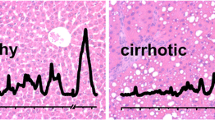Abstract
The woodchuck is one of the only lab animal models of chronic viral hepatitis infection and the development of hepatocellular carcinoma. Using this model, changes in tissue energetics in the liver due to the development of hepatocellular carcinoma can be monitored by repeated magnetic resonance imaging and localized phosphorus spectroscopy. Age- and sex-matched control (n=5) and chronically infected (n=5) adult woodchucks were imaged four times in a six-month period in a 7-T horizontal-bore magnet. Using a custom-built doubly tunable quadrature volume coil, sagittal and axial FLASH images (128×128, slice thickness = 5 mm, TR/TE=1000/4.1, 8 averages) were acquired to locate the largest portion of the liver with the least amount of signal contamination from surrounding abdominal muscle. Two-dimensional 31P chemical-shift imaging (2D-CSI) was acquired (16×16 data matrix, 24×24×2 cm3, 1024 data points, 16 averages) for all animals. The extent of liver injury was determined using serum gamma glutamyltransferase (GGT). The livers of infected woodchucks showed a significant increase (p=0.01) in phosphomonoesters (PME):β-adenosine triphosphate (NTP). Chronically infected woodchucks had higher levels of serum GGT compared to uninfected woodchucks (p=0.002). An increase in the PME:β-NTP ratio indicates cellular proliferation within the malignant tumor.
Similar content being viewed by others
References
Michalak TI (1998) The woodchuck animal model of hepatitis B. Viral Hepat Rev 4(3):139–165
Tennant BC (2001) Animal models of hepadnavirus-association hepatocellular carcinoma. Clin Liver Dis 5(1):43–68
Jacob JR, Sterczer A, Toshkov IA, Yeager AE, Korba BE, Cote PJ, Buendia M, Gerin JI, Tennant BC (2004) Integration of woodchuck hepatitis and N-myc rearrangement determine size and histologic grade of hepatic tumors. Hepatology 39(4):1008–1016
Hornbuckle WE, Graham ES, Roth L, Baldwin BH, Wickenden C, Tennant BC (1985) Laboratory assessment of hepatic injury in the woodchuck (Marmota monax). Lab Anim Sci 35(4):376–381
Tomanek B, Volotovskyy V, Gruwel MLH, McKenzie E, King SB (2005) Double-frequency birdcage volume coil for 4.7 T and 7 T. Concepts in Magnetic resonance. Part B, Magnetic Resonance Engineering, Wiley, US (in press)
Corbin IR, Ryner LN, Singh H, Minuk GY (2004) Quantitative hepatic phosphorus-31 magnetic resonance spectroscopy in compensated and decompensated cirrhosis. Am M Physiol Gastrointest Liver Physiol 287(2):G379–G384
Corbin I, Buist R, Volotovskyy V, Peeling J, Zhang M, Minuk GY (2002) Regenerative activity and liver function following partial hepatectomy in the rat using 31P-MR spectroscopy. Hepatology 36(2):345–353
Cox IJ, Bell JD, Peden CJ, Iles RA, Foster CS, Watanapa P, Williamson RCN (1992) In vivo and in vitro 31P magnetic resonance spectroscopy of focal hepatic malignancies. NMR Biomed 5(3):114–120
Francis IR, Chenevert TL, Gubin B, Collomb L, Ensminger W, Walker-Andrews S, Glazer GM (1991) Malignant hepatic tumours: P-31 MR spectroscopy with one-dimensional chemical shift imaging. Radiology 180(2):341–344
Lim AKP, Patel N, Hamilton G, Hajnal JV, Goldin RD, Taylor-Robinson SD (2003) The relationship of in vivo 31P MR spectroscopy to histology in chronic hepatitis C. Hepatology 37(4):788–794
Taylor-Robinson SD, Sargentoni J, Bell JD, Thomas EI, Marcus CD, Changani KK, Saeed N, Hodgson HJF, Davidson BR, Burrough BR, Rolles K, Foster CS, Cox IJ (1998) In vivo and in vitro hepatic phosphorus-31 magnetic resonance spectroscopy and electron microscopy in chronic ductopenic rejection of human liver allografts. Gut 42:735–743
Glazer GM, Smith SR, Chenevert TL, Martin PA, Steven AN, Edwards RHT (1989) Image localized 31P magnetic resonance spectroscopy of the human liver. NMR Biomed 1(4):84–189
Champbell KA, Wu Y, Chacko VP, Sitzmann JV (1990) In vivo 31P NMR spectroscopic changes during liver regeneration. J Surg Res 49:244–247
Author information
Authors and Affiliations
Corresponding author
Rights and permissions
About this article
Cite this article
McKenzie, E., Jackson, M., Sun, J. et al. Monitoring the development of hepatocellular carcinoma in woodchucks using 31P-MRS. MAGMA 18, 201–205 (2005). https://doi.org/10.1007/s10334-005-0120-x
Received:
Revised:
Accepted:
Published:
Issue Date:
DOI: https://doi.org/10.1007/s10334-005-0120-x




